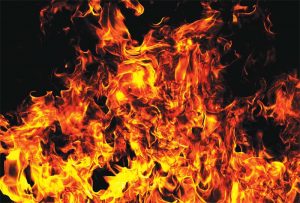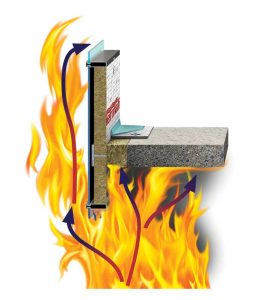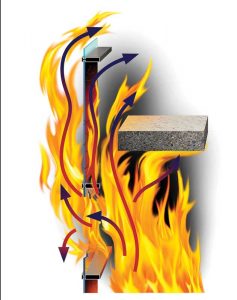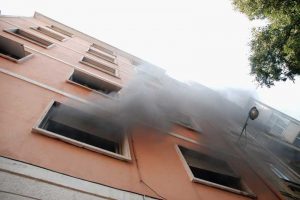Why all components matter in firestopping materials
by arslan_ahmed | June 8, 2023 5:11 pm
 [1]By Angie Ogino
[1]By Angie Ogino
Passive fire containment (PFC) systems in high-rise commercial buildings helps support a precious commodity—time—which allows occupants to safely egress a structure during a fire. By slowing the spread of fire and smoke within the building, PFC systems are designed to extend the amount of time available for occupants to exit the building and to increase the time within which firefighters can access the area of fire origin.
Today’s U.S. building codes require the firestopping materials installed in PFC systems to be tested to ASTM E2307, Standard Test Method for Determining Fire Resistance of Perimeter Fire Barriers Using Intermediate Scale, Multi-story Test Apparatus. This standard requires the subjection of firestopping systems to intensive and rigorous testing. Adherence to the code requirement for this testing contributes to the impressive safety record of buildings in the U.S.
Troubling trends
In the absence of a large-scale fire catastrophe, a sense of complacency may be influencing the specification of firestopping materials. In recent years, North America has seen a trend of pre-insulated back pans coming from overseas which contain foreign mineral wool that has not been tested to ASTM E2307. These panels make it difficult for building officials/inspectors to determine if certified mineral wool has been installed.
Fabricated panels—typically unitized curtain walls with spandrels pre-insulated with mineral wool within back pans—produced by some manufacturers, include firestopping materials which are marketed for firestopping purposes,
but contain mineral wool that is not tested in accordance with ASTM E2307, and the code requires firestopping systems that have been tested according to the standard.
To meet code requirements for “tested and listed” firestopping systems, each system must pass rigorous testing by an independent third-party organization such as Underwriters Laboratories (UL). The listing attests to the third-party’s assessment of the assembly’s performance under intense testing conditions. Specifying and installing an ASTM E2307-tested and -listed PFC system is a standard best practice for passive life safety systems in commercial high-rise buildings. The PFC approach relies on a “system,” comprising specific materials—mineral wool insulation, hangers, mullion covers, often times backer/reinforcement support, and firestop sealants—which are designed and tested to work together when installed in the perimeter of the building as part of a PFC system.
 [2]
[2]Mineral wool as a material and the manufacturing process
The purpose a material serves in a building, as well as the process used to manufacture it, must be considered during the specifying process.
Materials are not tested individually; systems comprising specific materials are tested. If a different product is substituted for any of the specific materials, then the entire system must be tested, not just the different product. For example, if the main work horse of the assembly, mineral wool, is substituted for another mineral wool product that has never proven its effectiveness in an ASTM E2307 test, then the whole assembly with the substituted mineral wool needs to be tested.
For the code and ASTM E2307, mineral wool is not tested by itself; the exact mineral wool product must be specifically named as a component of a tested system. A manufacturer of mineral wool, who is marketing their product for a PFC system, should verify their product has been tested as per ASTM E2307. For example, Intertek is a testing lab that lists mineral wool generically in their listings—meaning it does not call the mineral wool product out by name, but does state the insulation must be qualified by Intertek to be used in a PFC system. On the other hand, UL lists the mineral wool by its manufacturer and product name.
 [3]
[3]Renowned for its fire resistance, mineral wool insulation can deliver many different performance properties in the commercial building enclosure. The manufacturing process used to make the material influences the properties it delivers in the enclosure. Depending on the desired performance attribute, this versatile material may be produced to reduce noise in industrial processes, repel water in rainscreen applications, or absorb water in hydroponic settings. Installed in perimeter fire containment systems, mineral wool is designed specifically to deliver fire performance properties.
 [4]
[4]Specifically engineered manufacturing processes create mineral wool that will perform in extreme conditions. These processes deliver properties that allow the mineral wool to withstand extreme heat and maintain its structural integrity under intense fire exposure. For example, the mineral wool in an ASTM E2307 compliant system must demonstrate its ability to withstand direct flame impingement and temperatures exceeding 982 C (1,800 F) while retaining its stability. The stability of the material is essential when one considers the relatively lightweight components in the curtain wall, such as aluminum and various components, may start to deflect, melt, or show signs of failure as early as nine minutes into a fire. With all these performance requirements in mind, ASTM E2307 subjects firestopping materials to the extreme temperatures and pressure that occur during a commercial high-rise fire.
Testing conducted by this author’s company investigated how various types of mineral wool perform. The testing found a standard mineral wool industrial or acoustical board at 101.6-mm (4-in.) thick and with a density of 64.1 kg/m3
(4 pcf) does not provide the same level of fire protection as a certified curtain wall or safing insulation in an ASTM E2307-tested and -classified system. Specifiers should ensure firestopping materials including mineral wool and other components are tested to ASTM E2307.
Appreciating the role manufacturing plays in supporting mineral wool’s performance in perimeter fire containment systems makes it clear why the specific mineral wool insulation used in PFC systems, including pre-insulated panels, needs testing and verification to be implicit in third-party listing organizations and verified by ASTM E2307. Such third-party validation provides specifying architects and contractors, as well as building owners and occupants, with an independent measure of assurance that the firestopping materials installed can help withstand conditions and characteristics of a high-rise fire in commercial buildings and ensure safety.
Resisting pressure to downsize testing
While this article focuses on mineral wool used in firestopping applications, it should be noted ASTM E2307 assesses every component’s performance in the PFC system and how they work together to support system performance. Every fire is unique, but as the comprehensive design of ASTM E2307 considers the whole system, this test provides a more holistic approach to vetting the system, compared to testing where components are evaluated individually.
ASTM E2307 is not about individual materials in the PFC system; it is about the systems themselves, each of which comprises a specific assembly of specific materials which are tested to show that they will work together to perform as required.
The rigorous design of ASTM E2307 has clearly contributed to the robust safety record of buildings in the U.S. Unfortunately, some manufacturers are advocating for a reduced, smaller-scale test which would evaluate components individually without considering how the individual parts function to support system performance. Imagine a situation where mineral wool stands up to the fire, but lacks the mechanical integrity to stay securely in place as curtain wall components begin to fail.
Conclusion
Time moves forward and building materials advance, but delivering the highest level of life safety is a timeless responsibility for those who design and construct commercial buildings. Efforts to shorten or simplify the testing standard by validating individual components, instead of the system as a whole, should be stopped. Industry stakeholders as well as the North American Insulation Manufacturers Association (NAIMA) urge the industry to support ASTM E2307
for evaluating firestopping materials used in PFC systems.
- [Image]: https://www.constructionspecifier.com/wp-content/uploads/2023/06/2_bigstock-Fire-Blaze-Flames-On-Black-Bac-470577815.jpg
- [Image]: https://www.constructionspecifier.com/wp-content/uploads/2023/06/Protected-Perimeter-Joint.jpg
- [Image]: https://www.constructionspecifier.com/wp-content/uploads/2023/06/Unprotected-Perimeter-Joint.jpg
- [Image]: https://www.constructionspecifier.com/wp-content/uploads/2023/06/dreamstime_m_489928.jpg
Source URL: https://www.constructionspecifier.com/why-all-components-matter-in-firestopping-materials/
 Author
Author